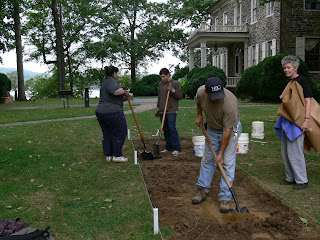The State Museum of Pennsylvania has again been accredited by the American Association of Museums, or the AAM. Accreditation is the highest national recognition for a museum, according to AAM. Only 775 of the estimated 17,500 museums operating in the United States – or about four percent – are currently accredited by AAM. This is the third time that The State Museum has earned this professional status, which is established through a rigorous peer review process conducted by AAM every ten to fifteen years.
Accreditation is conducted by a team of museum professionals who review the institution and assess collection stewardship practices as they compare to other institutions. It requires a thorough accounting of collection practices, review of institutional goals and objectives, and identifying efforts being made to improve conditions of collections.
The AAM report noted, “The State Museum of Pennsylvania is commended for its outstanding commitment to upgrading collections care even in the face of budgetary constraints.” An estimated 4.1 million artifacts and specimens are either exhibited or curated in high density storage equipment.
The State Museum first opened to the public in 1905 and moved to its current site at 300 North St., adjacent to the State Capitol Building, in 1965. The museum serves more than 130,000 visitors annually, including 60,000 students from across the state. Exhibit areas total more 100,000 square feet.
The large collections on display and in storage encompass paleontology, geology, botany, zoology, archaeology, art and significant industrial, political and domestic collections associated with the state’s history. The archaeology collection is the largest of these sections. The large volume of artifacts in our section is due in part to our responsibility as a State and Federal repository for archaeological collections produced from site investigations utilizing these funding sources.
An important role of a repository is providing access to collections for the purpose of scholarly research and insuring the security and preservation of artifacts. We encourage research of collections and have been fortunate to have many students and professionals produce manuscripts and publications based on research conducted at The State Museum. Some recent projects include Circular Villages of the Monongahela Tradition Dr. Bernard K Means, 2007, The Interpretation of Carved Faces Found on Boulders and Cobbles Stanley W. Baker Ohio Archaeologist, V.60,No.2 Spring 2010, and Salt-Glazed Stoneware in Early America Janine E. Skerry & Suzanne Findlen Hood The Colonial Williamsburg Foundation, Williamsburg, Virginia, 2009.
Many of you who follow our blog have read about collections that we received over the past few years that have increased our knowledge of Pennsylvania history and prehistory. We continue to strive to improve our public outreach and access to these collections via our blog and our web page. Thanks to the AAM for their resounding support of what we do at The State Museum which is to educate the public and preserve our rich Pennsylvania Heritage.
Celebrating our heritage is an important part of Fort Hunter Day which will be held on Sunday, September 19th at Fort Hunter Park. There will be musical presentations as well as craft demonstrations throughout the day. This is also where we will be continuing our excavations in search of the elusive evidence of a French & Indian War period fort.
We have removed the backfill from last year’s excavations and are cleaning up a prehistoric floor in our large unit before we tackle our possible well/cistern feature. Here are a few shots from the field this week- hope you can make it out to view our excavations and participate in the great activities at Fort Hunter Day 2010.

A newly recovered sidenotched point


More trench expansion in the side yard
No comments:
Post a Comment